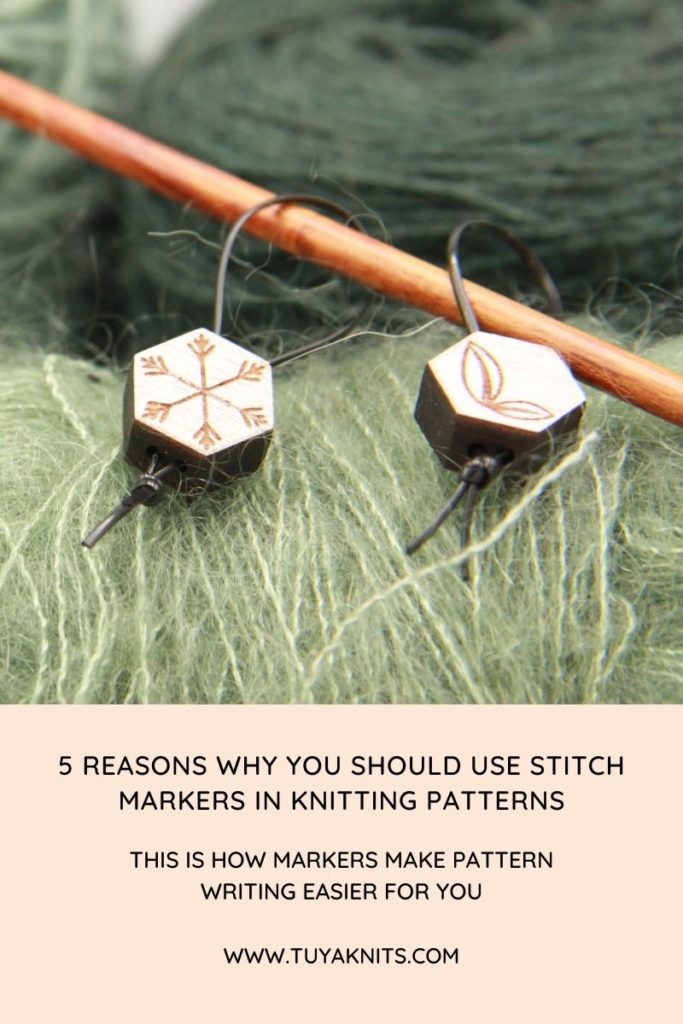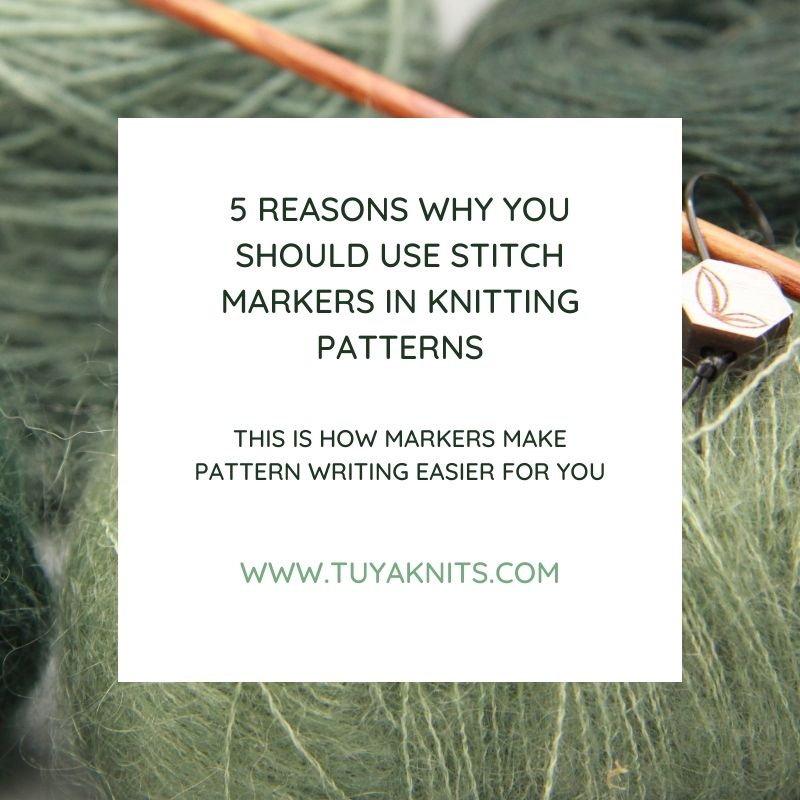Myös saatavilla|Also available in: Suomi (Finnish)
Does it ever feel that the directions of a seamless knitwear design are difficult to outline and explain in a knitting pattern? Do you need concrete benchmarks for writing a pattern so that, for example, the placements of shaping can be told in the pattern easily and really clearly? Including stitch markers in the pattern provides anchor points to describe all these events and makes writing a knitting pattern a lot easier.
1. Stitch marker as an indication of the beginning of a new round
Seamless knitting has been a trend for many years, and many knitters use seamless methods for everything from socks and other accessories to sweaters and cardigans.
When a garment is worked as a closed knit ie. in the round, as the work progresses, it can be difficult to discern where the change point from one round to next is, especially from a larger work. Instruct the knitter to place a stitch marker to the beginning of the round right on the first round of the work. This will help your knitter to keep track where a new round begins. This marker is called a beginning of round marker (BORm).
“Instruct the knitter to place a stitch marker to the beginning of the round right on the first round of the work.“
When placing a stitch marker, be sure to also tell where the marker is located in the work. If you are working a sweater from the top down, will the stitch marker be at the center of the back neck? If a sweater is started from the hem, will the marker be on either side of the body? Telling the location of the beginning of round marker will help both you as a pattern writer and your knitter to outline the directions of the work at hand concretely.
“Telling the location of the beginning of round marker will help both you as a pattern writer and your knitter to outline the directions of the work at hand concretely.“
2. Stitch markers show the placements of increases or decreases
Knitwear designs usually include shaping at various points to make a design work properly for its intended purpose. Different forms of shaping include, for example, raglan increases or decreases, increases or decreases at the sides of a sweater, or increases made at the thumb gusset of a mitten.
When you get to the stage where the work will be shaped, tell the knitter to place stitch markers at these shaping points.
“When you get to the stage where the work will be shaped, tell the knitter to place stitch markers at these shaping points.”
Stitch markers indicating the locations of shaping are usually inserted to the work just before the shaping begins. So, it is a good idea to include a special round in this section to describe the placing of new stitch markers.
As there hopefully already is a beginning of round marker in the work, describe the placing of the first shaping marker in relation to that. Then, continue by giving the number of stitches that the knitter must work from the stitch marker just added before the next marker is placed.
“As there hopefully already is a beginning of round marker in the work, describe the placing of the first shaping marker in relation to that.“
When all shaping markers are in their correct places, it will be easy to describe the locations of shaping in the pattern in relation to the markers.
3. Stitch markers help perceive the structure of a shawl
Stitch markers are not only useful for projects worked in the round. In shawls, there is a lot happening on any row – for example, shaping is happening next to the edges and / or on either side of the center stitch, or the shawl is shaped by working short rows.
Therefore, instruct the knitter to place a stitch marker at the points where changes occur in relation to different sections and structure of the shawl.
“Therefore, instruct the knitter to place a stitch marker at all points where changes occur in relation to different sections or structure of the shawl.”
As with the sweater patterns, including markers to shawl patterns will help the pattern writer to outline the directions of the shawl and to keep track which stitches belong to which structural section of the shawl. The use of stitch markers makes writing a pattern easier and more concrete because events on any rows can be described by referring to stitch markers.
4. Stitch markers help keeping pattern repeats in place
A knitter of lace, colorwork, or cable projects knows how stitch markers make it easier to keep pattern repeats in place on rows / rounds bustling with yarn overs, color changes, or cable twists and turns. This is especially the case if the pattern repeat is very long, or it is difficult to keep up with the pattern repeats for some other reason.
Have the knitter place stitch markers on each side of long pattern repeats. You can also mark the locations of markers on the charts, if you want to.
“Have the knitter place stitch markers on each side of long pattern repeats.“
Having a lot of markers in the work may seem like an overkill. But perhaps you could test the concept with an existing pattern and see what the instructions would look like if markers were placed on each side of complete pattern repeats?
5. Stitch marker as a reference point for short rows
Sometimes, to describe short rows, it’s a good idea to place a short row marker in the work. The marker could be a ring marker placed on the needle or a removable marker that is hung in the work only for working the short rows.
If the marker is a hanging-on-the-needle type of marker, write a set-up round for placing this marker to the work before starting the short rows.
“If the marker is a hanging-on-the-needle type of marker, write a set-up round for placing this marker to the work before starting the short rows.“
If a removable marker is attached directly on the work and is not carried along as the work progresses, state the exact location of placing the marker by specifying how many stitches from the beginning of round marker (or any other suitable marker) should be worked before attaching it. As the short rows are continued, give the stitch counts to be worked on each short row in relation to the marker just attached.
“If a removable marker is attached directly on the work and is not carried along as the work progresses, state the exact location of placing the marker by specifying how many stitches from the beginning of round marker (or any other suitable marker) should be worked before attaching it.”
As soon as the short rows have been completed, the removable stitch marker is removed from the work.
* * * * *
In this article, I have outlined the reasons why the use of stitch markers should be written in knitting patterns and how they make it easier to write a knitting pattern.
Do you include the use of stitch markers in your knitting patterns? Would you also recommend using markers in situations other than those mentioned in this article? Loved to hear your insights!
FURTHER READING: 11 IDEAS FOR YOUR STYLE GUIDE – COMPILE A TOOL TO HELP YOU WRITE KNITTING PATTERNS
TIP: CHECK OUT TUYAKNITS STITCH MARKERS HERE!


Be the first to comment